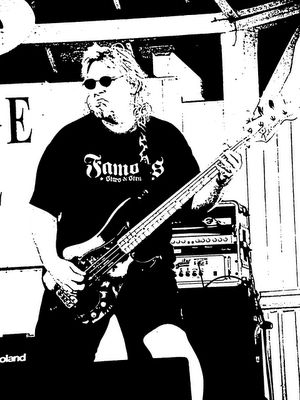
If you've been working at the powerplant and wondering "What does it all mean?" "How in the name of all that is good does thing work?" I hope that the following helps. Keep in mind that in order for the pictures and the captions to download in the right order, I had to write the article backwards, so the photo you're looking at was the last one I downloaded. With that said, enjoy!
Downloaded by Hello
Older Posts
Tuesday, May 31, 2005

The intake tower is where the process starts, and it has two functions. One is to clean the air coming into the turbine and the other is to cool the air. Behind the air cleaner is a Swamp Cooler. Water is injected at the top of the tower and it runs down a series of special pads that works pretty much like the swamp cooler at home. Cooling the air makes the air denser and more power can be generated. This is the same concept of an intercooler for a supercharger in a car.
Posted by Hello

The CTG is nothing more than a jet engine that is designed to spin a generator instead of providing thrust. Air from the outside enters from the right, is compressed, mixed with fuel and ignited.
Posted by Hello

The thousands of blades in the CTG draw in air from the air inlet and compress it as the blades get smaller. Once the compressed air reaches the combustion chamber or "can" it is mixed with natural gas and ignited in a continuous process. The rapidly expanding gas exits through another series of blades that has two functions: One, to turn the compressor blades. Two, to rotate an AC Generator that is connected to the shaft.
Posted by Hello

The Heat Recovery Steam Generator or HRSG (pronounced Her-Zig) takes the fast moving exhaust from the combustion turbine and slows it down, first through a diffuser and then through a maze of water filled pipes. The water in the pipe turns to steam and is super-heated.
Posted by Hello

After the heat is transfered to the HeRSiG, the exhaust is cleaned and exits through the stacks into the atmosphere, but wait, the story doesn't end here.
Posted by Hello

The Steam that is generated in the HeRSiG is sent to the STG or "Steam Turbine Generator". The STG looks very similar to the CTG (Combustion Turbine Generator) in that it has many rotor blades, but no combustion of flammable gas takes place. As the steam moves through the STG the blades rotate and generate electricity by turning a generator on the end of the shaft. The spent steam is sent to a condensator that uses cool water from the cooling towers to turn the steam back into water, and then it is pumped back to the HeRSiG to repeat the process.
Why all this extra fuss to make steam? It's free baby, and free means extra profit, and extra profit means more jobs! Ok maybe the job thing was going a little too far but you never know. The existing plant (units 1 and 2) by comparison, just boiled water to make steam so if you consider the cost of Gas, it makes sense to get all the energy you can out of a product. Like Martha says "It's a good thing".
Posted by Hello
Monday, May 30, 2005

Future Jam? Wayne Foulds and Mike Brown are plotting to join musical forces this June. Stay tuned for future anouncements on when and where!
Posted by Hello
Mountainview Trivia
On the name plate of the generators at the power plant you will notice that it states that the generator is "Hydrogen Cooled." Why Hydrogen instead of air? According to the second edition of NADON and GELMINE'S "INDUSTRIAL ELECTRICITY" there are two types of alternators: One is a Salient Pole type where many projecting field poles are mounted on a cast iron spider. Since the number of poles determine the speed at which the alternator spins, a Salient Pole alternator need not spin at high RPMs. A 24 pole alternator therefore has to spin at 300 RPMS to produce 60Hz. The other type of alternator is a Turbo-Type. A steam turbine has a higher efficiency when operated at high speeds which makes the designing a Salient Pole machine difficult because of the high centrifugal forces. Projecting poles also cause excessive wind losses and make the alternator noisy. To overcome these undesirable features, alternators intended for steam-turbines have their field structures made cylindrical in form and small in diameter, with two or four poles. Because of this streamlining, however, it becomes difficult to cool the alternator. To overcome this problem, hydrogen is used instead of air. Hydrogen being much lighter than air causes 10% less windage loss which also reduces noise. Also, hydrogen is a better heat conductor than air enabling 20% more power to be supplied from a given machine. Another benefit is less oxidation in the windings.
So there it is folks. You would have thought that they would have learned a lesson from the Hindenburg, but here we are mixing a flammable gas and electricity. Go figure!
Saturday, May 28, 2005
Add your own comments
Wednesday, May 25, 2005
The Man - The Myth - The Legend
Posted by Hello
Saturday, May 21, 2005

Me and Don (check out my hat, I look like Father Guido Sarducci)
Posted by Hello
Friday, May 20, 2005

Don Boatman shooting loops
Posted by Hello

Teresa at the 4160 MCC
Posted by Hello

James McInenly worked his way to the top...of the HeRSiG. Not only working in the heat, but having to climb the stairs to the top of the HeRSiG takes stamina.
Posted by Hello

Ron Wright
Posted by Hello
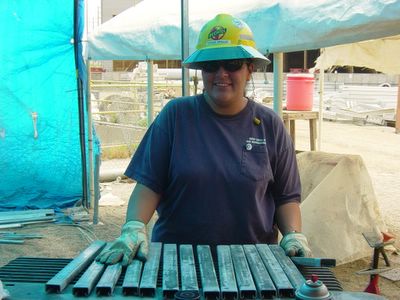
Teresa Araujo at the Pre-Fab area.
Posted by Hello

Matthew Ward outside the 4160 MCC
Posted by Hello

Jeniffer Burns checking up on the men.
Posted by Hello

Edward Cerda (he wasn't as suprised as he looks)
Posted by Hello
Sunday, May 15, 2005
This weeks Man-of-the-hour

Same smile, different job. Without Lauren Citron's hard work and dedication to his position in Temporary Power, We would all be using hand tools. Here's to you Lauren!
Posted by Hello
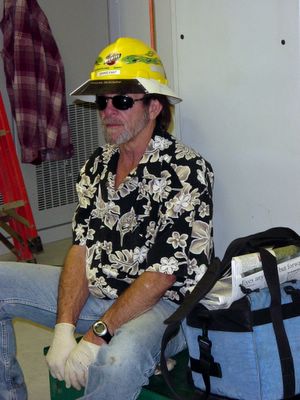
Dennis East in the STG PEC (Mountainview Power Plant)
Posted by Hello
Thursday, May 12, 2005

4th Year students hard at work and looking forward to the summer.
Posted by Hello
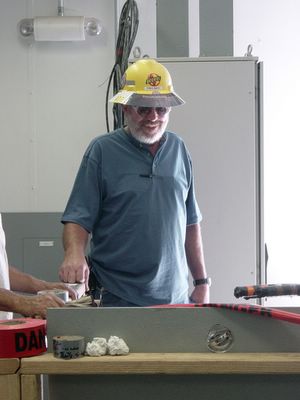
Fred Smith at the 4160 MCC Unit 4
Posted by Hello
Referral Procedure Changes
I haven't had time to process the information about the new changes to the referral system with the two strikes sending you to the back of the book, but having looked over the letter from Edwin Hill I can see that this change will cause a few waves, as well as the rules for termination or "discharge for cause."
I would like to hear anyones point of view on this subject, just click on the "# COMMENTS" below to add a comment.
Monday, May 09, 2005

G.F. Joe Serrano looks over plans at Mountainview Power Plant
Posted by Hello

Jeff Gianni and Joe Serrano use "Construction Sign Language" because of the high noise level. Here Jeff is giving the sign for "two pair shielded wire"
Posted by Hello

Greg Temple doesn't need a tugger
Posted by Hello
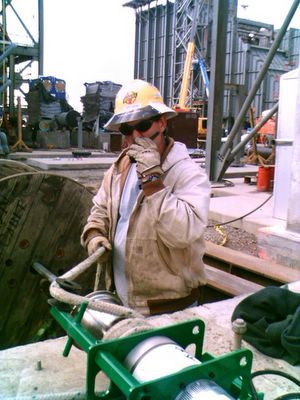
Jeff Gianni operating a Greenlee Tugger (Mountainview Power Plant)
Posted by Hello

Mike Strader taking a well deserved break at the Mountainview Power Plant
Posted by Hello
Older Posts







